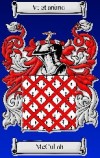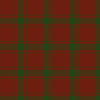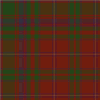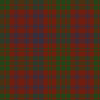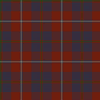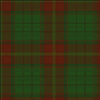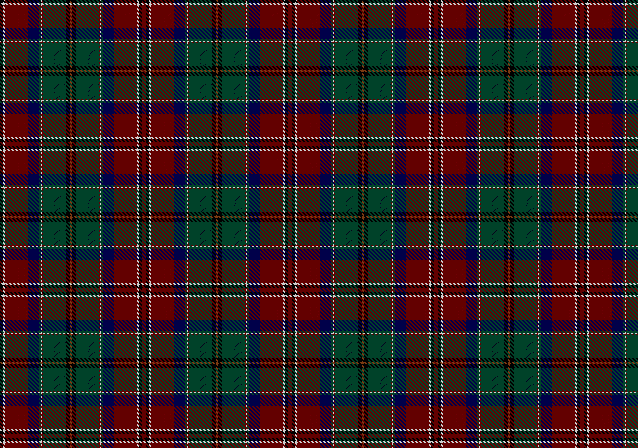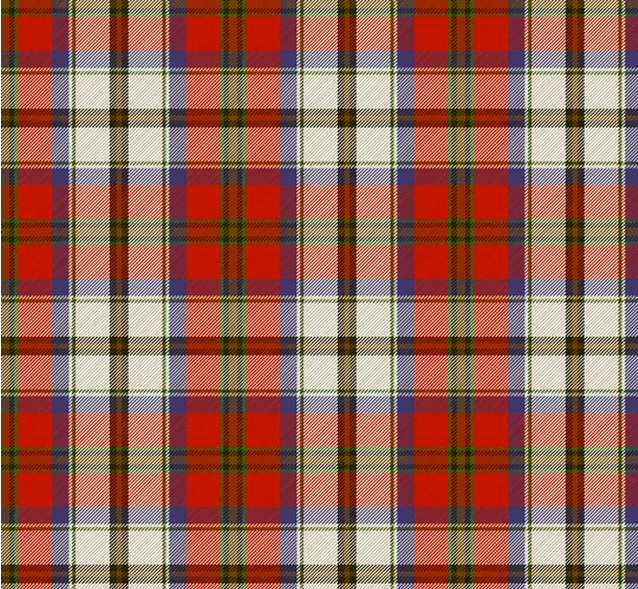Tartans
The MacCulloch/MacCullough Tartan
by Rodney McCulloh
Have you seen the ancient McCulloh tartan? Hmmm…, neither have I. The tartan shown below was created by Peter MacDonald for a Mr. Donald McCullogh of ‘MacCulloch Highlands’ in the USA for use by all of the name MacCullogh/MacCulloch and variants. This tartan was registered with the Scottish Tartans Authority in 2000 and is identified as ITI number 3340. To understand why the McCulloch tartan is so new we have to understand a little of the history of tartan.
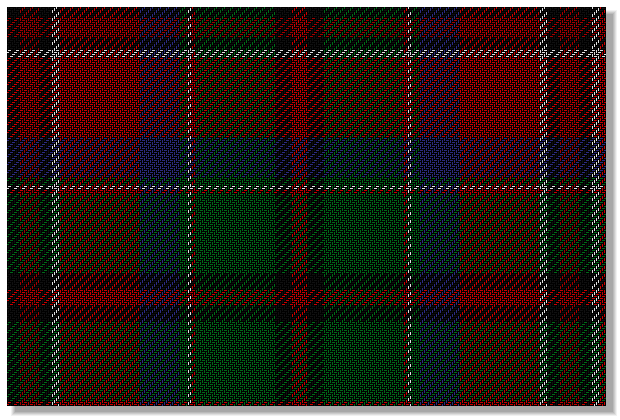 Close-up view of new MacCulloch/MacCullough Tartan
Close-up view of new MacCulloch/MacCullough Tartan
It is not really known when tartan first came into existence. Originally the word ‘tartan’ indicated a type of cloth, not the plaid pattern we understand the term to mean today. Even into the 19th century the term ‘tartan’ had a dual meaning; referring to either the type of cloth or to the pattern woven into the cloth. A small piece of woven plaid known as the ‘Falkirk sett’ and used as a bottle stopper in the 3rd century A.D. has been discovered during an excavation in Scotland. For this article, suffice it to say that tartan is first clearly documented as being worn by the highland Scots in the 16th century though it had certainly been worn by many preceding generations of Scots by this time. James V was the first member of the royal family to order a Highland outfit back in 1538. (Although we correlate tartan to kilts today, James V ordered his tartan for a coat and trousers.)
Most Scottish tartans are relatively new with the oldest going back less than 300 years. Historically Scottish Tartan belonged to the Highland Scotts. However, the unpopularity of the Act of Union in 1707 brought tartan to the Lowlands where Lowland ladies adopted it as a sign of their disapproval. Between the Scottish uprisings of 1715 and 1745 kilts of tartan seem to have become established as the chief item of Highland dress. (Though the kilt is now worn by all Scots it was not that long ago that the Lowland Scots were disgusted by the kilt and considered it to be a primitive form of dress.) In 1745 Bonnie Prince Charles led the Jacobite rebellion in his quest to regain the throne of Great Britain. The uprising ended in 1746 with the slaughter of the Scottish warriors at the Battle of Culloden . Extremely harsh measures were taken by the British against the Highlanders and in 1747 the wearing of tartan and Highland dress was outlawed except by soldiers of the Highland regiments of the British army. For the next 35 years those caught wearing tartan could be sentenced to six months in jail for a first offence and transported to the colonies for seven years for a repeat offence. During this time many of the tartan patterns were lost due to the confiscation and destruction of tartan cloth and garments. In 1782 the Dress Act was repealed and tartan began a slow come back.
The tartan weaver Wilsons of Bannockburn has a record of a MacCulloch tartan in about 1820 but that pattern has been lost to time. In the book “Tartan for Me,” a MacCulloch/MacCullough tartan is listed. However, Scottish tartan designer Peter MacDonald indicates this is the same pattern as that for MacDonald of Sleat.
He goes on to say that for some unknown reason, the MacDonald of Sleat tartan has been (improperly) recorded somewhere along the line in the last 50 years as a MacCulloch tartan. The Scottish Tartan Authority lists the MacDonald of Sleat tartan as a MacDonald tartan but also lists an almost identical tartan dated 1845 named MacCullough with an alternate name of MacDonald of the Isles of MacCulloc. (It should be noted that the Scottish Tartan Authority is not a legal body with some type of government authority to regulate tartan; rather it is a registered charity formed in 1996 to promote a deeper knowledge of Scottish Tartans.)
So, did our direct ancestors ever have a tartan pattern of their own? It seems unlikely. The idea of tartan being used in ancient times to identify clans or families is disputed by many authorities. Hardly any patterns (setts) in use by clans today can be traced to early times and there is no proof that any of them in early times had clan or family designations associated with them. Additionally, if you are familiar with our ancestry you will recall that our ancestors were most likely Lowland Scots that emigrated to Northern Ireland as much as 100 years before tartan made its way to the Lowlands. What’s more we were already in America when the 1745 Jacobite rebellion took place. Consequently, any tartan worn by our direct ancestors would probably have occurred well over 100 years prior to the earliest documented clan tartan pattern records currently in existence. Although it is not impossible that our Scots-Irish ancestors had a tartan there are simply no records or documents to support this.
Tartan has gained international popularity and new clan, district, commemorative, corporate, institutional and sporting tartans are routinely being created. While it may be a little disappointing to learn that there probably isn’t an “ancient McCulloh tartan” moldering in an attic or trunk somewhere waiting to be discovered, it is exciting to know that a new McCullough tartan finally does exist. Mr. Donald McCullough of Maryland, USA (relation to our line not established) has had a new McCullough/MacCulloch tartan designed (by Peter MacDonald) and registered with the Scottish Tartan Authority in 2000. The design is based on the the fact that the McCulloh’s are considered ‘septs‘ of the MacDougall, Munro and Ross clans. This gives us the ‘right’ to wear the tartan of these clans. Our ancestry in northern Ireland would also allow for the wearing of the Irish Ulster tartan. (Actually there is no overall system for controlling tartan and anyone has the right to wear any tartan they choose. Of course they shouldn’t misrepresent its historical family or clan association.) Given these associations, Mr. McCullough asked Mr. McDonald to include elements of the MacDougall, Ross, Galloway, and the Irish Ulster tartans in the new design.
The design is beautiful and the custom woven cloth can be ordered from house-of-tartan in Scotland. (Pattern 3214)
Sources:Tartans of Scotland – 1978, Lutterworth Press, Guildford and London
The History of Tartan – 2005, Anness Publishing Ltd – London
The Descendants of Captain John McCollough (1770-1847) And Anna Elizabeth Spangler (1779-1858) – 2006, Mark and Curtis McCollough
E-mail from Donald McCullough – Posted at: web.ukonline.co.uk/t.mcculloch/mcculloch/1.html
Scottish Clan & Family Encyclopedia – 1998, Barnes & Noble, Inc.
Clans and Families of Scotland – 1999, Chartwell Books

